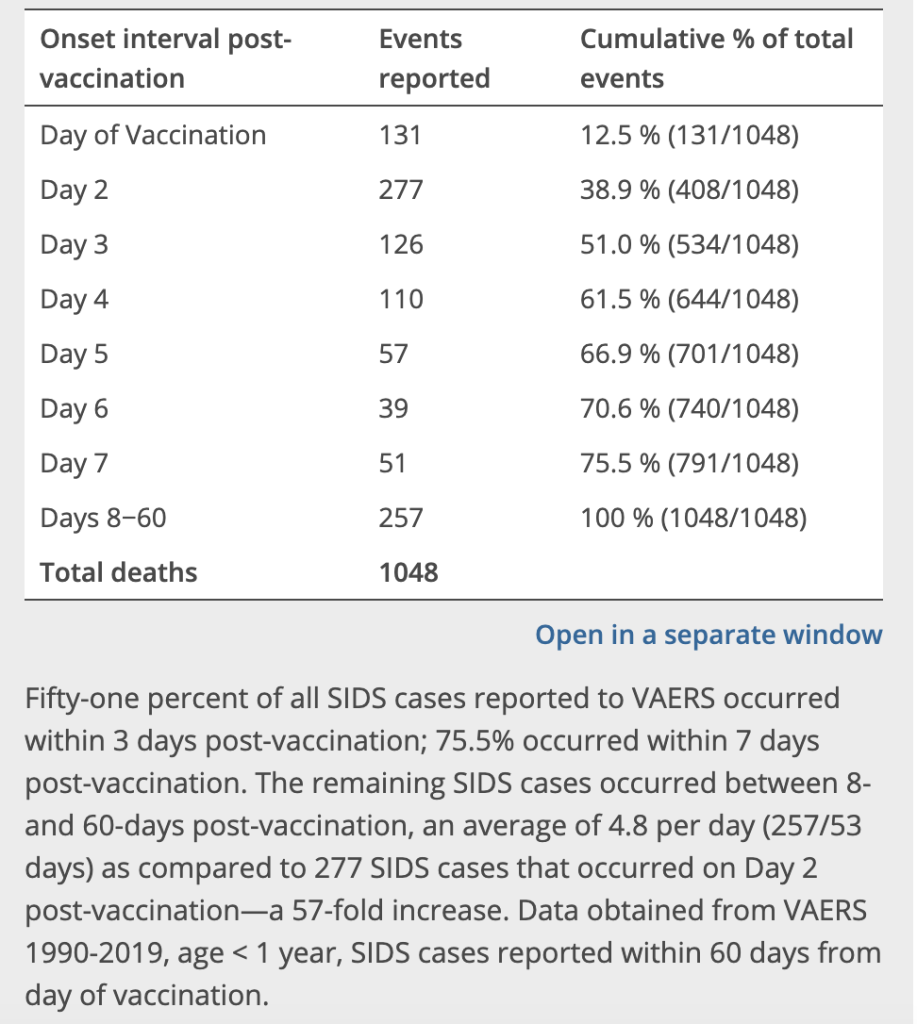TODDLER twins died of sudden infant death syndrome (SIDS) a week after receiving three vaccines containing neurotoxins. The police immediately suspected the parents and launched a murder investigation, despite a family history of adverse reactions to vaccination.
On April 23, Dallas Shaw and her brother Tyson, 18 months old, received shots for flu, hepatitis A, and the combined diphtheria, tetanus and pertussis vaccine (DTaP). Their mother Andrea Shaw and Andrea’s mother-in-law both told the doctor that her husband’s family had a history of adverse reactions to the flu vaccine. They were assured by the doctor that all would be well.
The twins, from Peyette, Idaho, woke the next morning with blue lips and were lethargic. They were taken to the ER and sent home. A week later, on May 1, their mother found them unresponsive. Paramedics could not revive them. The distraught parents immediately came under suspicion and were interrogated by police.
Parents are told vaccines are safe, but critical care specialist Dr Pierre Kory has said that ‘many studies show a temporal link between vaccinations and infant deaths’. One was published in 2021 by the Institute of Medical and Scientific Inquiry, New Mexico, whose team trawled the Vaccine Adverse Event Reporting System (VAERS) database for SIDS cases and unearthed alarming statistics. Between 1990 and 2019, around 75 per cent of SIDS occurred within seven days of vaccination. Around 12 per cent of those deaths were recorded on day one and just over 25 per cent on day two. Dr Kory said: ‘Some studies found that 90 per cent of all deaths occur within seven days of vaccines.’
In 1983, at the request of the UK’s chief scientist, Dr Gordon Stewart, emeritus professor of public health at the University of Glasgow and a world authority on vaccine safety, wrote a 150-page report stating the pertussis (whooping cough) element of the DTaP vaccine could cause permanent brain damage and death. It was submitted to the Department of Health but remains unpublished, despite updates in 1998 and 2006.
When you look at vaccine ingredients, a side effect of SIDS is perhaps not surprising although denied by the manufacturers and healthcare regulators. Biologist and chemist Brian Hooker, Emeritus Professor at Simpson University, Redding, California said: ‘The DTaP contains at least 300 micrograms of aluminium as well as polysorbate 80. The hepatitis A contains polysorbate 80 and 600 micrograms of aluminium.’
Polysorbate 80 can cause anaphylaxis and cognitive decline. It is used as a delivery system that disrupts the blood brain barrier allowing the aluminium, a neurotoxin that can cause seizures, directly into the brain. Paediatricians rarely consider these as culprits, and the US Food and Drug Administration (FDA) say these limits are safe. The World Health Organization (WHO) say babies ingest more aluminium through breast milk than they receive in vaccines and that aluminium is excreted through the kidneys.

How did we get to a place where toxic ingredients are ignored while loving parents are demonised? We know there are abusive parents, but SIDS babies show no signs of physical distress or deliberate asphyxiation.
Although the diphtheria vaccine was introduced in 1942 and offered free, and the polio vaccine in 1956. 1959 marks a turning point where the UK moved from ad-hoc or local vaccination efforts to a nationally organized, NHS-supported childhood immunisation program. Just 11 years later, SIDS became a registrable cause of death. It was thought to be a ‘coincidence’ that babies suffered unexplained cot death around the time they receive their first round of vaccines. In the UK, that is currently at two, three and four months old, and there are around 200 SIDS deaths per year. SIDS charities such as the Lullaby Trust dismiss any connection although Lullaby recognise that: ‘The peak age for SIDS is 1-2 months; 91 per cent of SIDS deaths happen when babies are six months old or less.’
Retired research scientist Dr Viera Scheibner was one of the first to publicly make a connection. She monitored hundreds of infants post-vaccination with apnoea monitors and noticed an increased pattern of breathing irregularities. She said babies became most distressed 48 hours post vaccination, which tallies with the VAERS reports. Authorities quickly moved to discredit her, and her research was dismissed by public health bodies including the Royal College of Paediatrics and Child Health, and the WHO.
In the 80s and 90s, two British doctors pushed the hypothesis that ‘abusive parents were getting away with murder’, further deflecting the spotlight from vaccines and other environmental hazards as a cause of SIDS. They also pushed Munchausen’s Syndrome by Proxy (MSBP), the mental health issue where a parent fabricates illnesses in their children to get attention for themselves. They blamed the majority of SIDS on ‘harassed, low-income young mothers’, and their theory landed innocent mothers with life prison sentences.
It was 1982, at the International Research Conference on The Sudden Infant Death Syndrome in Baltimore, that Dr David Southall, consultant paediatrician at Alder Hey Children’s Hospital, Liverpool, advanced his murder theory to 250 scientists and health professionals from America and 12 other countries.
Professor Sir Roy Meadow, consultant paediatrician at Great Ormond Street Children’s Hospital, London, who testified in child protection cases, published a paper on MSBP in 1977, a theory that Dr Southall helped to promote. That same year, he coined ‘Meadow’s Law’ and stated that ‘one sudden infant death is a tragedy, two is suspicious, and three is murder, until proved otherwise’. This statistic was later debunked by the epidemiologist Professor Sir Richard Doll. In 1977, he had published a paper on MSBP, a theory Dr Southall helped to promote.
Both Meadow and Southall were struck off by the General Medical Council (GMC) for serious professional misconduct but not before their hypotheses took hold and landed innocent mothers in prison, as in the 1999 and 2002 cases of Sally Clark and Angela Cannings.
In 1999, Mrs Clark, a solicitor from Cheshire, was convicted of murdering her two sons, 11-week-old Christopher and eight-week-old Harry. Meadow’s Law was used to convict her. They died a year apart and Mrs Clark was sentenced to life, but the jury never heard that Harry died just five hours after receiving his DTaP vaccine and Christopher 23 days receiving his. The family made no connection either, although their GP did.
The Clarks had a third child, Tom (not his real name), born before his mother’s trial. In the book Stolen Innocence, Mrs Clark tells how their GP, Dr Case, recommended against vaccinating Tom but would give no reason. Mrs Clark’s husband Steve challenged Dr Case and she said that given the family history, she did not want to take responsibility for vaccinating Tom. Their consultant suggested a blood test to check Tom’s health. It found he had a low white-blood-cell count and that his immune system was not working. The GP’s instinct was right. Tom was not fit enough for a vaccine. How many other babies who later die of SIDS are vaccinated when they are under par?
Angela Cannings, a former supermarket worker, lost three children to SIDS. In 1989, her first child Gemma died at 13 weeks. In 1991 Jason died at seven weeks, and in 1999 Matthew died at 18 weeks. Matthew had been vaccinated shortly before his death but again, the jury at Mrs Cannings’s trial were not told. She was convicted of murder and handed a life sentence.
Both women appealed and were freed. Harry Clark was found to have had a severe staphylococcal infection in his spinal fluid indicating sepsis or meningitis. In Mrs Cannings’s case the appeal court ruled that there was no evidence of foul play and Meadow’s evidence was discredited. But the women’s lives were destroyed. Mrs Clark died of alcoholism in 2007 at the age of 42, and Mrs Cannings’s marriage to her husband Terry failed.
Meadow was struck off in 2005 for giving misleading statistical evidence at Sally Clark’s trial. Southall was struck off in 2007 after he wrongly accused Mr Clark of murdering their children based on his appearance in a television documentary, and for moving confidential records from one hospital to another without permission. Both appealed and, disappointingly, were reinstated.
Around the same time as SIDS, shaken baby syndrome (SBS) was highlighted in the British Medical Journal in a paper published in 1971 by British paediatric neurosurgeon Dr Norman Guthkelch of the Royal Manchester Children’s Hospital.
SBS has a triad of symptoms, Dr Guthkelch said: bleeding around the brain, and in the eyes, and swelling of the brain. He hypothesised that this was caused by whiplash. In frustration at a crying baby, instead of comforting it a parent would shake it so hard the brain would bang the sides of the skull and begin to swell and bleed. There was just one problem: these babies showed no neck trauma, a fact identified by paediatric neuropathologist and expert witness Dr Waney Squier, from John Radcliffe Hospital, Oxford. For years, Dr Squier had accepted this diagnosis and testified against parents at numerous trials, until she noticed these babies had no neck trauma. She sounded the alarm and said publicly that SBS had not been rigorously validated, especially in courtrooms. ‘Science is not a belief system. You don’t believe in shaken baby syndrome any more than you believe in gravity,’ she said. She was struck off by the GMC in 2016 ‘for being dishonest in her dealings with six cases in the family court which brought the reputation of the medical profession into disrepute’. She was reinstated on appeal later that year.
Meanwhile, Dr Southall and Dr Meadow’s legacies prevail and prevent other causes being investigated.
On day two of the Shaws’ interrogation, police told Mrs Shaw that the deaths of Dallas and Tyson were not medical and that ‘they figured asphyxiation’. She said: ‘They said that I had supposedly had a postpartum overwhelming blackout and done it to my children.’
Nathaniel Shaw told detectives he was angry they thought his wife had the capacity to murder their only children ‘as she was such a loving and caring mother to the point where even new foods, she would go through everything that was in it as an ingredient to make sure that nothing was toxic’.
Mrs Shaw, who is ‘beyond devastated’, said: ‘They were just normal, perfect, happy little babies. They had already learned to crawl, walk and say some words, including “mamma” and “dadda”. We cannot come to terms with this tragedy.’
The criminal investigation into the Shaws’ case is continuing.











